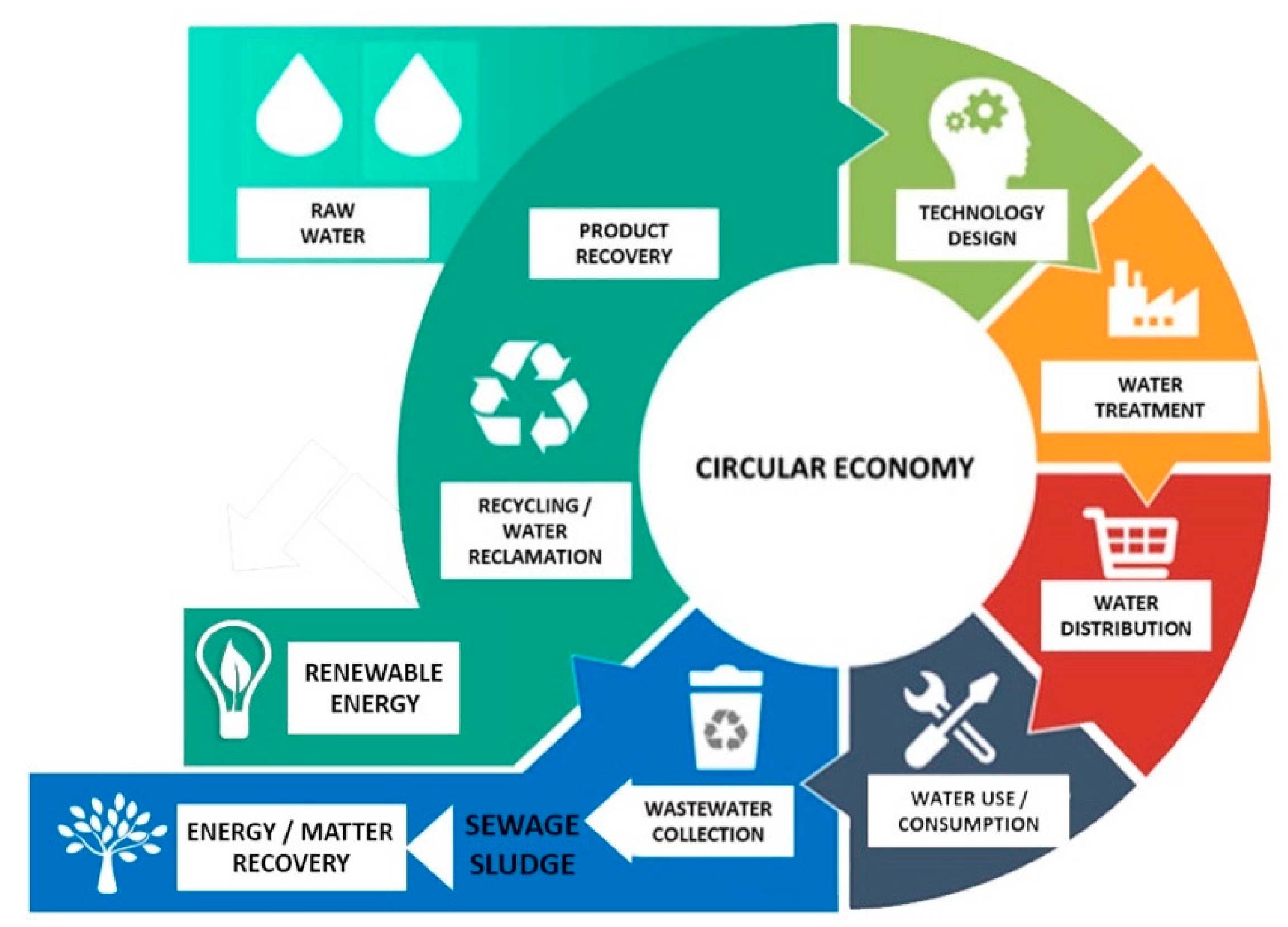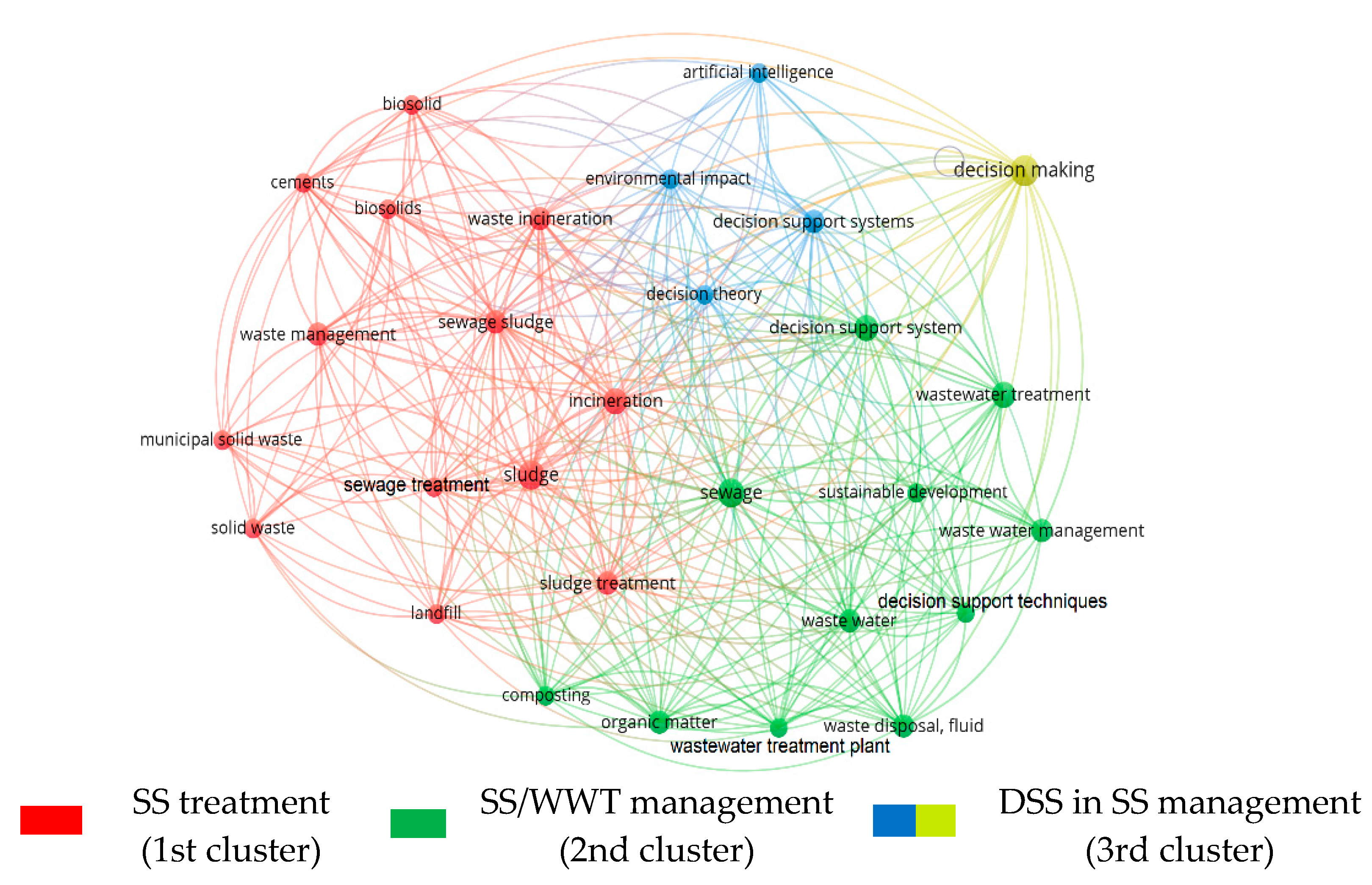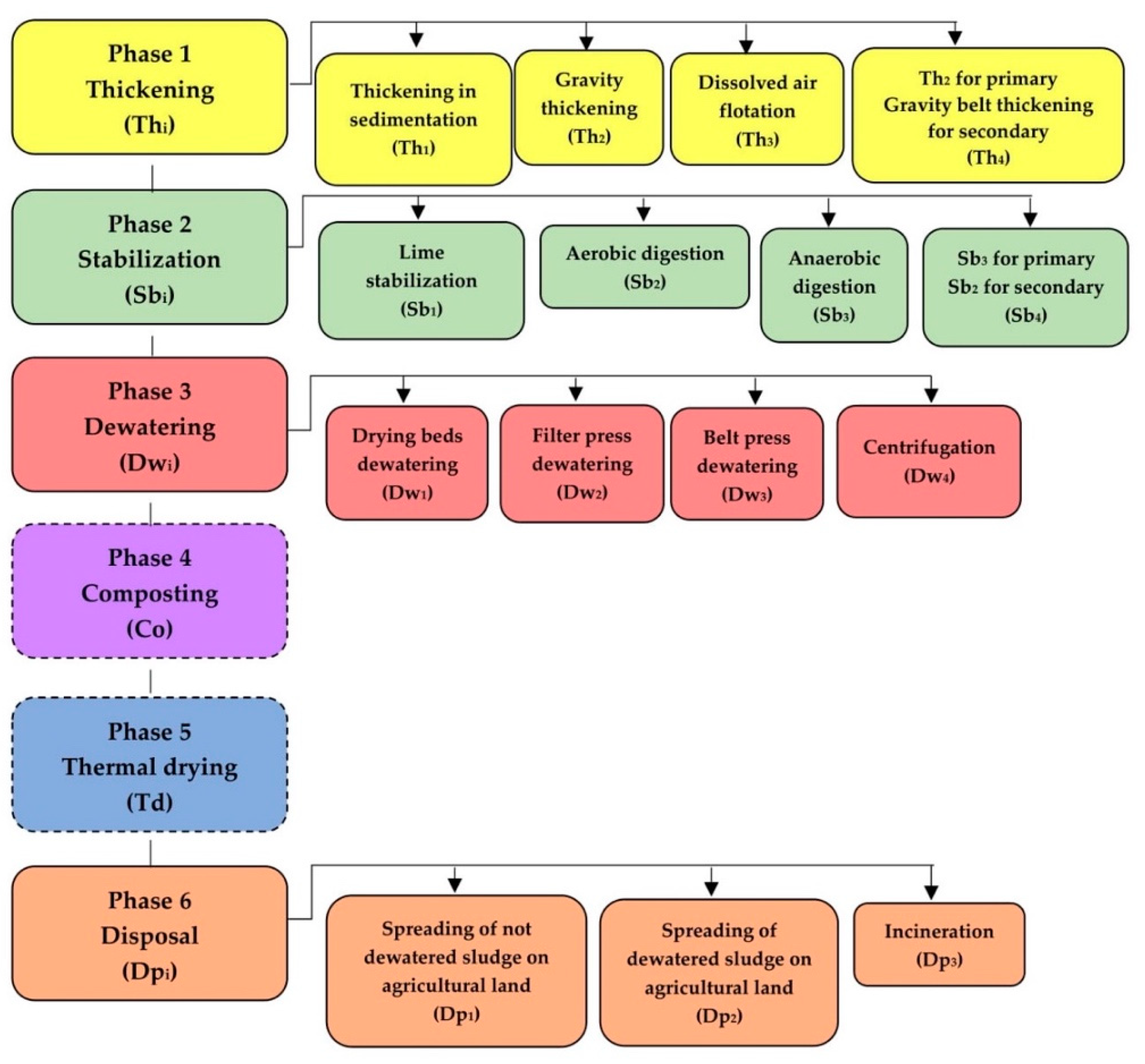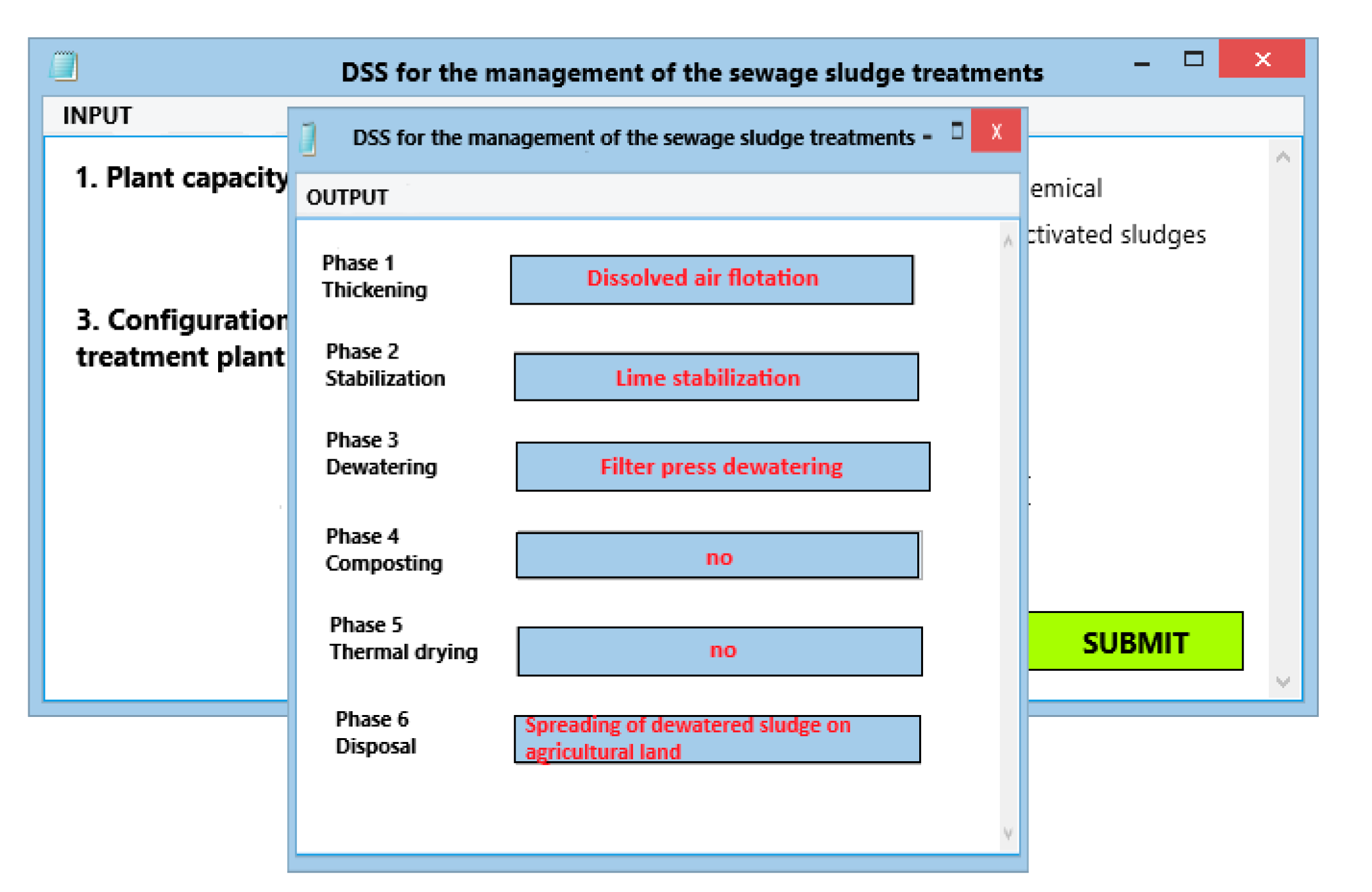A Neural Network Model for Decision-Making with Application in Sewage Sludge Management
Abstract
:1. Introduction
- Which SS treatments are available on the market and which combination of these can be considered more efficient in economic terms and consistent with a circular water value chain?
- What are the key drivers that affect the SS treatment efficiency?
- Does any tool exist to support decisions regarding SS treatment and to guarantee an effective management of SS?
2. Literature Review
- Subset 1: keywords related to SS treatment and its principal sub-processes (e.g., SS, SS management, WWT, WW, etc.).
- Subset 2: keywords related to sustainability (e.g., circular economy, green, environment, greenhouse gas, etc.).
- Subset 3: keywords related to decision support systems (DSSs) in SS management (e.g., decision theory, decision making, decision support techniques, etc.).
3. Materials and Methods
4. Results and Discussions
5. Conclusions
Author Contributions
Funding
Institutional Review Board Statement
Informed Consent Statement
Data Availability Statement
Conflicts of Interest
Abbreviations
| ANN | Artificial neural network |
| BP | Back-propagation |
| CH4 | Methane |
| Co | Composting |
| CO2 | Carbon dioxide |
| Csp | Configuration of the sewage sludge treatment plant |
| DEMATEL | Decision-making trial and an evaluation laboratory |
| Dp1 | Spreading of not dewatered sludge on agricultural land |
| Dp2 | Spreading of dewatered sludge on agricultural land |
| Dp3 | Incineration |
| Dpi | Disposal |
| DSS | Decision support system |
| Dw1 | Drying beds dewatering |
| Dw2 | Belt press dewatering |
| Dw3 | Filter press dewatering |
| Dw4 | Centrifugation |
| Dwi | Dewatering |
| GHG | Greenhouse gas |
| GRNN | Generalized regression neural network model |
| KPI | Key performance indicator |
| LCA | Life cycle assessment |
| LFPPFAHP | Logarithmic fuzzy preference programming based fuzzy analytic hierarchy process |
| MAD | Mean Absolute Deviation |
| MAE | Mean Absolute Error |
| MAPE | Mean Absolute Percentage Error |
| MCDM | Multiple-criteria decision-making |
| ME | Mean Error |
| MSE | Mean Squared Error |
| N2O | Nitrous oxide |
| PC | Plant capacity |
| PE | Population equivalent |
| RMSE | Root mean square error |
| Sb1 | Lime stabilization |
| Sb2 | Aerobic digestion |
| Sb3 | Anaerobic digestion |
| Sb4 | Anaerobic digestion for primary sludge and aerobic digestion for secondary sludge |
| Sbi | Stabilization |
| SLNA | Systematic literature network analysis |
| SS | Sewage sludge |
| SSTS | Sewage sludge treatment system |
| St | Secondary treatment |
| Td | Thermal drying |
| Th1 | Thickening in sedimentation |
| Th2 | Gravity thickening |
| Th3 | Dissolved air flotation |
| Th4 | Gravity thickening for primary sludge and gravity belt thickening for secondary sludge |
| Thi | Thickening |
| VBA | Visual Basic for Applications |
| W | Wavelet |
| WTE | Waste-to-energy |
| WW | Wastewater |
| WWT | Wastewater treatment |
| WWTP | Wastewater treatment plant |
References
- Digiesi, S.; Mossa, G.; Rubino, S. A sustainable EOQ model for repairable spare parts under uncertain demand. IMA J. Manag. Math. 2015. [Google Scholar] [CrossRef]
- Shaddel, S.; Bakhtiary-Davijany, H.; Kabbe, C.; Dadgar, F.; Østerhus, S.W. Sustainable sewage sludge management: From current practices to emerging nutrient recovery technologies. Sustainability 2019, 11, 3435. [Google Scholar] [CrossRef] [Green Version]
- Chai, C.; Zhang, D.; Yu, Y.; Feng, Y.; Wong, M.S. Carbon footprint analyses of mainstream wastewater treatment technologies under different sludge treatment scenarios in China. Water 2015, 7, 918–938. [Google Scholar] [CrossRef]
- Kelessidis, A.; Stasinakis, A.S. Comparative study of the methods used for treatment and final disposal of sewage sludge in European countries. Waste Manag. 2012. [Google Scholar] [CrossRef]
- Digiesi, S.; Mossa, G.; Rubino, S. Sustainable order quantity of repairable spare parts. IFAC Proc. Vol. IFAC Pap. 2012, 2, 181–186. [Google Scholar] [CrossRef]
- Smol, M.; Adam, C.; Preisner, M. Circular economy model framework in the European water and wastewater sector. J. Mater. Cycles Waste Manag. 2020. [Google Scholar] [CrossRef] [Green Version]
- De Oliveria Neto, G.C.; Pinto, L.F.R. Drivers to promote sustainability as operational strategy: Cross content analysis. J. Environ. Account. Manag. 2019, 7, 395–408. [Google Scholar]
- Kacprzak, M.; Neczaj, E.; Fijalkowski, K.; Grobelak, A.; Grosser, A.; Worwag, M.; Rorat, A.; Brattebo, H.; Almas, A.R.; Singh, B.R. Sewage sludge disposal strategies for sustainable development. Environ. Res. 2017. [Google Scholar] [CrossRef] [PubMed]
- Vadenbo, C.; Guillén-Gosálbez, G.; Saner, D.; Hellweg, S. Multi-objective optimization of waste and resource management in industrial networks—Part II: Model application to the treatment of sewage sludge. Resour. Conserv. Recycl. 2014. [Google Scholar] [CrossRef]
- Turunen, V.; Sorvari, J.; Mikola, A. A decision support tool for selecting the optimal sewage sludge treatment. Chemosphere 2018. [Google Scholar] [CrossRef] [PubMed]
- Bratina, B.; Sorgo, A.; Kramberger, J.; Ajdnik, U.; Zemljic, L.F.; Ekart, J.; Safaric, R. From municipal/industrial wastewater sludge and FOG to fertilizer: A proposal for economic sustainable sludge management. J. Environ. Manag. 2016. [Google Scholar] [CrossRef]
- Gutiérrez, M.C.; Serrano, A.; Siles, J.A.; Chica, A.F.; Martín, M.A. Centralized management of sewage sludge and agro-industrial waste through co-composting. J. Environ. Manag. 2017. [Google Scholar] [CrossRef]
- Buonocore, E.; Mellino, S.; de Angelis, G.; Liu, G.; Ulgiati, S. Life cycle assessment indicators of urban wastewater and sewage sludge treatment. Ecol. Indic. 2018. [Google Scholar] [CrossRef] [Green Version]
- Abuşoğlu, A.; Özahi, E.; Kutlar, A.İ.; Al-Jaf, H. Life cycle assessment (LCA) of digested sewage sludge incineration for heat and power production. J. Clean. Prod. 2017. [Google Scholar] [CrossRef]
- Wielgosiński, G.; Cichowicz, R.; Targaszewska, A.; Winiewski, J. The Use of LCA Method to Assess Environmental Impact of Sewage Sludge Incineration Plants. Ecol. Chem. Eng. S 2017. [Google Scholar] [CrossRef] [Green Version]
- Gourdet, C.; Girault, R.; Berthault, S.; Richard, M.; Tosoni, J.; Pradel, M. In quest of environmental hotspots of sewage sludge treatment combining anaerobic digestion and mechanical dewatering: A life cycle assessment approach. J. Clean. Prod. 2017. [Google Scholar] [CrossRef]
- Kabugo, C.; Jämsä-Jounela, S.L.; Schiemann, R.; Binder, C. Industry 4.0 based process data analytics platform: A waste-to-energy plant case study. Int. J. Electr. Power Energy Syst. 2020. [Google Scholar] [CrossRef]
- Chauhan, A.; Jakhar, S.K.; Chauhan, C. The interplay of circular economy with industry 4.0 enabled smart city drivers of healthcare waste disposal. J. Clean. Prod. 2020. [Google Scholar] [CrossRef]
- Bertanza, G.; Baroni, P.; Canato, M. Ranking sewage sludge management strategies by means of Decision Support Systems: A case study. Resour. Conserv. Recycl. 2016. [Google Scholar] [CrossRef]
- An, D.; Xi, B.; Ren, J.; Ren, X.; Zhang, W.; Wang, Y.; Dong, L. Multi-criteria sustainability assessment of urban sludge treatment technologies: Method and case study. Resour. Conserv. Recycl. 2018. [Google Scholar] [CrossRef]
- Naqvi, S.R.; Tariq, R.; Hameed, Z.; Ali, I.; Taqvi, S.A.; Naqvi, M.; Niazi, M.B.K.; Noor, T.; Farooq, W. Pyrolysis of high-ash sewage sludge: Thermo-kinetic study using TGA and artificial neural networks. Fuel 2018. [Google Scholar] [CrossRef]
- Zeinolabedini, M.; Najafzadeh, M. Comparative study of different wavelet-based neural network models to predict sewage sludge quantity in wastewater treatment plant. Environ. Monit. Assess. 2019. [Google Scholar] [CrossRef]
- Huang, Y.W.; Chen, M.Q. Artificial neural network modeling of thin layer drying behavior of municipal sewage sludge. Meas. J. Int. Meas. Confed. 2015. [Google Scholar] [CrossRef]
- Harder, R.; Peters, G.M.; Molander, S.; Ashbolt, N.J.; Svanström, M. Including pathogen risk in life cycle assessment: The effect of modelling choices in the context of sewage sludge management. Int. J. Life Cycle Assess. 2016. [Google Scholar] [CrossRef] [Green Version]
- Durdević, D.; Trstenjak, M.; Hulenić, I. Sewage sludge thermal treatment technology selection by utilizing the analytical hierarchy process. Water 2020, 12, 1255. [Google Scholar] [CrossRef]
- Laura, F.; Tamara, A.; Müller, A.; Hiroshan, H.; Christina, D.; Serena, C. Selecting sustainable sewage sludge reuse options through a systematic assessment framework: Methodology and case study in Latin America. J. Clean. Prod. 2020. [Google Scholar] [CrossRef]
- Ren, J.; Liang, H.; Dong, L.; Gao, Z.; He, C.; Pan, M.; Sun, L. Sustainable development of sewage sludge-to-energy in China: Barriers identification and technologies prioritization. Renew. Energy Rev. 2017. [Google Scholar] [CrossRef] [Green Version]
- Ogris, C.; Helleday, T.; Sonnhammer, E.L.L. PathwAX: A web server for network crosstalk based pathway annotation. Nucleic Acids Res. 2016. [Google Scholar] [CrossRef] [Green Version]
- Rodriguez Pinto, L.F.; Pereira Venturini, G.D.F.; Digiesi, S.; Facchini, F.; de Oliveira Neto, G. Sustainability assessment in manufacturing under a strong sustainability perspective—An ecological neutrality initiative. Sustainability 2020, 12, 9232. [Google Scholar] [CrossRef]








| Reference | Dimension | MCDM | Method Features | |||
|---|---|---|---|---|---|---|
| Tec. | Ec. | Env. | Soc. | |||
| Vadenbo et al. [9] | × | × | √ | × | × | multi-objective mixed-integer linear program |
| Harder et al. [24] | × | × | √ | × | × | LCA-QMRA |
| Bertanza, Baroni and Canato [19] | √ | √ | √ | √ | √ | Home-made solution D-sight (PROMETHEE and GAIA) |
| An et al. [20] | √ | √ | √ | √ | √ | LFPPFAHP and Ex-tension theory |
| Buonocore et al. [13] | × | × | √ | × | × | LCA |
| Gourdet et al. [16] | × | × | √ | × | × | LCA |
| Abuşoğlu et al. [14] | × | × | √ | × | × | LCA |
| Turunen, Sorvari and Mikola [10] | √ | √ | √ | √ | √ | MAVT |
| Wielgosiński et al. [15] | × | × | √ | × | × | LCA |
| Durdević, Trstenjak and Hulenić [25] | √ | √ | √ | √ | √ | AHP |
| Naqvi et al. [21] | √ | √ | √ | × | × | ANN |
| Zeinolabedini and Najafzadeh [22] | √ | √ | × | × | × | ANN |
| Huang and Chen [23] | × | √ | √ | × | × | BP-ANN GRNN |
| Laura et al. [26] | √ | √ | √ | √ | √ | Multi-attribute analysis |
| Kacprzak et al. [8] | √ | √ | √ | √ | √ | Multi-attribute analysis |
| Ren et al. [27] | √ | √ | √ | √ | √ | DEMATEL |
| Phase | Treatment | Strengths | Limitations |
|---|---|---|---|
| Phase 1 Thickening (Thi) | Thickening in sedimentation (Th1) | Low investment costs. | Water treatment interruption due to sludge removal. |
| Gravity thickening (Th2) | Moderate investment and management costs. Simple management of the process. Storage capacity. | Long detention times. It captures only sedimentable solids. | |
| Dissolved air flotation (Th3) | Reduced detention times. Good reduction of suspended substances. | Considerable investment and management costs. | |
| Gravity thickening for primary sludge and gravity belt thickening for secondary sludge (Th4) | The best treatment for both primary and secondary sludge. Good solids content in the sludge. Storage capacity. | Hard management. |
| Phase | Treatment | Strengths | Limitations |
|---|---|---|---|
| Phase 2 Stabilization (Sbi) | Lime stabilization (Sb1) | Simple management. Low sensitivity to toxic discharges. Good removal of heavy metals. | High operating costs due to the use of chemical reagents. Production of high volumes of sludge. |
| Aerobic digestion (Sb2) | Low investment and management costs. Low sensitivity to external factors. Low sensitivity to toxic discharges. No production of bad odors. | Intake of oxygen from the external environment is required. Sensitivity to climatic changes. | |
| Anaerobic digestion (Sb3) | Intake of oxygen from the external environment is not required. Low energy consumption. Low production of stabilized sludge. High reduction of the pathogens in the sludge. Energy recovery. | Very high investment and management costs. Hard process management. | |
| Anaerobic digestion for primary sludge and aerobic digestion for secondary sludge (Sb4) | Lower energy costs. Only primary sludge is subjected to anaerobic digestion. | Complex management of the processes. |
| Phase | Treatment | Strengths | Limitations |
|---|---|---|---|
| Phase 3 Dewatering (Dwi) | Drying beds dewatering (Dw1) | Low investment costs. Low employment of highly specialized workers. Low energy and chemical reagents consumption. Low sensitivity to sludge characteristics. | High usage of area of land. The sludge must be previously stabilized. Climatic factors must be considered for the sizing of the system. |
| Belt press dewatering (Dw2) | Low energy consumption. Low investment and management costs. Simplicity of construction and maintenance. Good dry content of the treated sludge. | Production of bad odors. High sensitivity to sludge characteristics. Automatic management is not recommended. Dimensional reduction of the influent sludge. | |
| Filter press dewatering (Dw3) | High dry content of the treated sludge. Moderate solid concentration in the filtered. | Discontinuous functioning. High investment and management costs. Special support structures are required. High usage of space. Highly specialized workers are required. | |
| Centrifugation (Dw4) | Good containment of bad odor emissions. Quick start and stop. High dry content of the dewatered sludge. | Specific maintenance required. Sand removal and sludge size reduction required. Need for highly qualified workers. High investment costs for medium-small plants. |
| Phase | Treatment | Strengths | Limitations |
|---|---|---|---|
| Phase 4 Composting (Co) | Good correction and fertilization capacity of the compost. Good level of stabilization. Compost can be stored better than sludge. Material recovery. | Need to use a filler. In some cases, high management costs. Production of bad odors. | |
| Phase 5 Thermal drying (Td) | Very high dry content of the sludge. Very high reduction of volume and weight of sludge. | Need to dewater sludge before treating it. |
| Phase | Treatment | Strengths | Limitations |
|---|---|---|---|
| Phase 6 Disposal (Dpi) | Spreading of not dewatered sludge on agricultural land (Dp1) | Low investment costs. Material recovery. Soil correction and fertilization. | High transport and storage costs. |
| Spreading of dewatered sludge on agricultural land (Dp2) | Low transport and storage costs. Material recovery. Soil correction and fertilization. | High investment costs. | |
| Incineration (Dp3) | Almost complete elimination of water. Almost complete stabilization. Suitable also for the treatment of fresh sludge. Energy recovery. | Very high investment and management costs. Very hard management. Need to strongly dewater the sludge before treating it. Need to manage fumes. |
| Input Parameter | Unit of Measurement | Range | Typology |
|---|---|---|---|
| PC | (PE) | #1: [0, 5E3] #2: [5E3, 10E3] #3: [10E3, 20E3] #4: [20E3, 100E3] #5: [100E3, +∞] | Class |
| St | (#) | 0: chemical treatment 1: activated sludge | Binary |
| CSp | (#) | 0: single line 1: separated line | Binary |
| Characteristic | Value |
|---|---|
| Dataset (Training, Validation, Testing) | 210-63-27 |
| Architecture (Input/Hidden/Output) | 3-27-6 |
| Structure | RNN |
| Activations | Sigmoid |
| Gradient update rules | Stochastic gradient descent |
| Target | ME | MAD | MSE | MAE | MAPE (%) |
|---|---|---|---|---|---|
| Thi | 0.143 | 0.286 | 0.429 | 0.286 | 13.69 |
| Sbi | 0.071 | 0.357 | 0.357 | 0.357 | 17.26 |
| Dwi | 0.214 | 0.214 | 0.214 | 0.214 | 9.52 |
| Co | −0.071 | 0.214 | 0.214 | 0.214 | 17.86 |
| Td | 0.071 | 0.214 | 0.214 | 0.214 | 14.29 |
| Dpi | 0.357 | 0.500 | 0.643 | 0.500 | 16.67 |
| Average | 0.131 | 0.298 | 0.345 | 0.298 | 14.88 |
Publisher’s Note: MDPI stays neutral with regard to jurisdictional claims in published maps and institutional affiliations. |
© 2021 by the authors. Licensee MDPI, Basel, Switzerland. This article is an open access article distributed under the terms and conditions of the Creative Commons Attribution (CC BY) license (https://creativecommons.org/licenses/by/4.0/).
Share and Cite
Facchini, F.; Ranieri, L.; Vitti, M. A Neural Network Model for Decision-Making with Application in Sewage Sludge Management. Appl. Sci. 2021, 11, 5434. https://doi.org/10.3390/app11125434
Facchini F, Ranieri L, Vitti M. A Neural Network Model for Decision-Making with Application in Sewage Sludge Management. Applied Sciences. 2021; 11(12):5434. https://doi.org/10.3390/app11125434
Chicago/Turabian StyleFacchini, Francesco, Luigi Ranieri, and Micaela Vitti. 2021. "A Neural Network Model for Decision-Making with Application in Sewage Sludge Management" Applied Sciences 11, no. 12: 5434. https://doi.org/10.3390/app11125434
APA StyleFacchini, F., Ranieri, L., & Vitti, M. (2021). A Neural Network Model for Decision-Making with Application in Sewage Sludge Management. Applied Sciences, 11(12), 5434. https://doi.org/10.3390/app11125434







